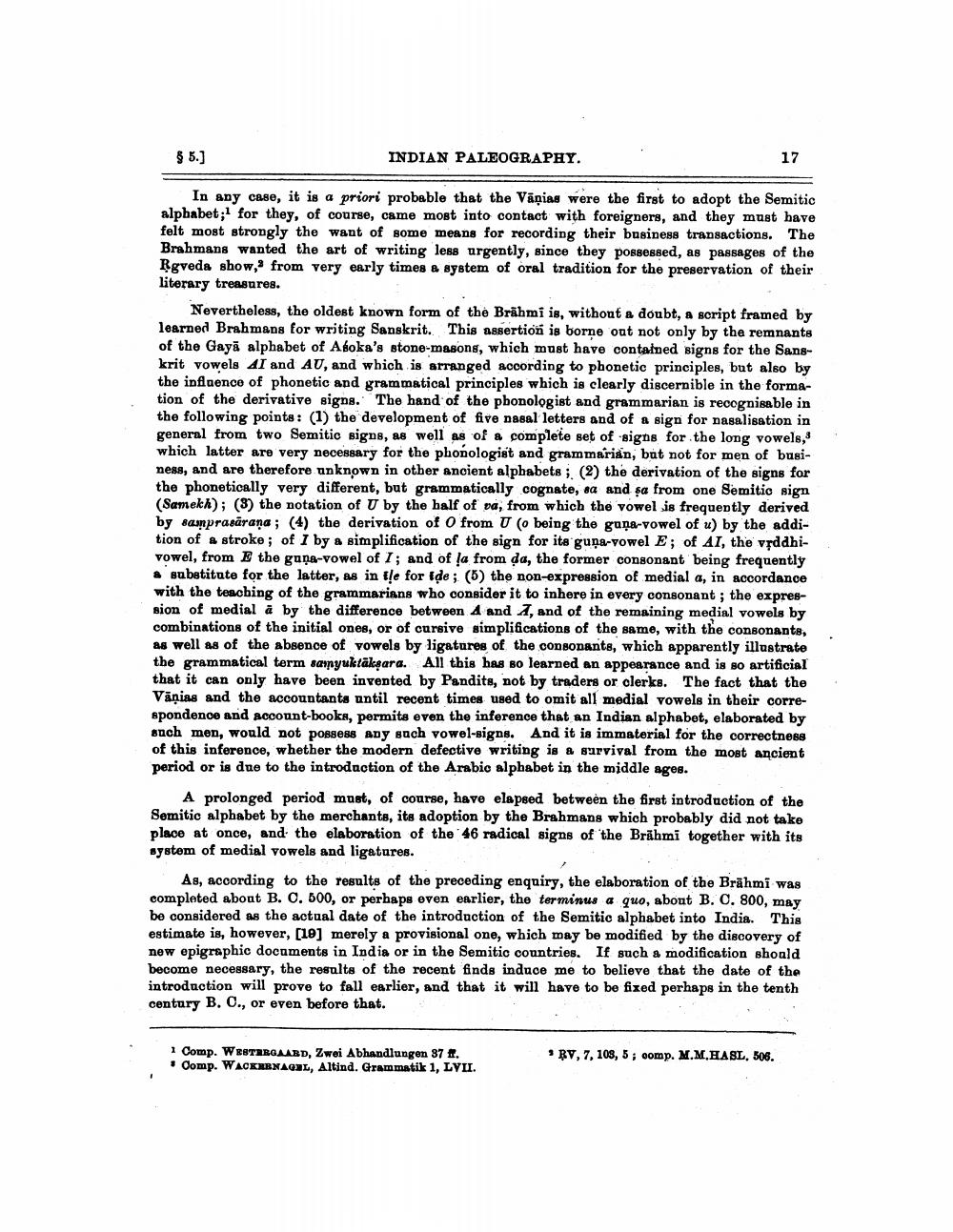________________
$ 5.]
INDIAN PALEOGRAPHY.
17
In any case, it is a priori probable that the Vāņias were the first to adopt the Semitic alphabet;1 for they, of course, came most into contact with foreigners, and they must have felt most strongly the want of some means for recording their business transactions. The Brahmans wanted the art of writing less urgently, since they possessed, as passages of the Rgveda show," from very early times & system of oral tradition for the preservation of their literary treasures.
Nevertheless, the oldest known form of the Brähmi is, without a doubt, a script framed by learned Brahmans for writing Sanskrit. This assertion is borne out not only by the remnants of the Gayā alphabet of Aboka's stone-masons, which must have contained signs for the Sangkrit vowels AI and AU, and which is arranged according to phonetic principles, but also by the influence of phonetic and grammatical principles which is clearly discernible in the formation of the derivative signs. The hand of the phonologist and grammarian is recognisable in the following points: (1) the development of five pasal letters and of a sign for nasalisation in general from two Semitic signs, as well as of a complete set of signs for the long vowels, which latter are very necessary for the phonologist and grammarian, but not for men of business, and are therefore unknown in other ancient alphabets ; (2) the derivation of the signs for the phonetically very different, but grammatically cognate, sa and sa from one Semitic sign (Samekk); (3) the notation of U by the half of va, from which the vowel is frequently derived by samprasarana ; (4) the derivation of O from U (o being the guna-vowel of u) by the addition of a stroke; of 1 by a simplification of the sign for its guņa-vowel E; of AI, the vçddhivowel, from E the gana-vowel of I; and of ļa from da, the former consonant being frequently & substitute for the latter, as in tle for ide; (5) the non-expression of medial a, in accordance with the teaching of the grammarians who consider it to inhere in every consonant; the expression of medial å by the difference between A and , and of the remaining medial vowels by combinations of the initial ones, or of cursive simplifications of the same, with the consonants, as well as of the absence of vowels by ligatures of the consonants, which apparently illustrate the grammatical term sayuktakşara. All this has so learned an appearance and is so artificial that it can only have been invented by Pandits, not by traders or clerks. The fact that the Vāņias and the accountants antil recent times used to omit all medial vowels in their correspondence and account-books, permits even the inference that an Indian alphabet, elaborated by anch men, would not possess any such vowel-signs. And it is immaterial for the correctness of this inference, whether the modern defective writing is a survival from the most ancient period or is due to the introduction of the Arabic alphabet in the middle ages.
A prolonged period must, of course, have elapsed between the first introduction of the Semitic alphabet by the merchants, its adoption by the Brahmans which probably did not take place at once, and the elaboration of the 46 radical signs of the Brāhmi together with its system of medial vowels and ligatures.
As, according to the results of the preceding enquiry, the elaboration of the Brähmi was completed about B. 0. 500, or perhaps even earlier, the terminus a quo, about B. C. 800, may be considered as the actual date of the introduction of the Semitic alphabet into India. This estimate is, however, [19] merely a provisional one, which may be modified by the discovery of new epigraphic documents in India or in the Semitic countries. If such a modification should become necessary, the results of the recent finds induce me to believe that the date of the introduction will prove to fall earlier, and that it will have to be fixed perhaps in the tenth century B. O., or even before that.
* Comp. WESTERGAARD, Zwei Abhandlungen 87 #.
Comp. WACKARNAGIL, Altind. Grammatik 1, LVII.
· RV, 7, 108, 5; comp. M.M. HASL, 506.




